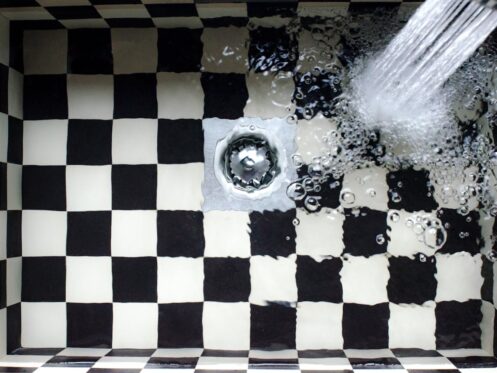Dealing with a clogged drain can be a frustrating experience, but it’s a common household issue that almost everyone will face at some point. Whether it’s in the kitchen, bathroom, or laundry room, a blockage can disrupt your routine and cause significant inconvenience. Fortunately, many clogs can be resolved without professional help if you know the right steps and have the proper tools on hand.
Understanding the signs of a clogged drain is the first step in tackling the problem. Slow drainage, unusual noises, and unpleasant odors are all indications that you might be dealing with a blockage. Taking immediate action when you notice these symptoms can prevent minor issues from turning into major problems.
Recognizing the Signs of a Clogged Drain
Common symptoms of a clogged drain can often be noticed early, allowing you to address the problem before it worsens. One of the most obvious signs is slow drainage. If water takes longer than usual to drain from sinks, showers, or tubs, it indicates that something is blocking the flow. Other symptoms include gurgling or bubbling sounds coming from the drain, which suggests trapped air caused by the obstruction. Unpleasant odors are another telltale sign, as trapped debris begins to decompose and send foul smells back up through the pipes.
Understanding the causes of blockages can help in preventing them from occurring. Common culprits include hair, soap scum, food particles, grease, and small objects that accidentally fall into the drain. In kitchen sinks, grease and food particles often form a stubborn clog, while in bathrooms, hair and soap residue are the usual suspects.
Immediate action is important when dealing with a clogged drain. Ignoring the early signs can lead to complete blockage, causing water to back up and potentially overflow, leading to water damage in your home. Additionally, a clogged drain can become a breeding ground for bacteria and mold, posing health risks to your household. Acting swiftly can help you avoid these complications.
Basic Tools and Materials Needed
To tackle a clogged drain effectively, you need the right tools and materials. Here is a list of essential items:
- Plunger: A good quality plunger is indispensable. It uses suction to dislodge blockages.
- Drain Snake: Also known as a plumber’s snake, this flexible tool can reach and pull out clogs deep within the pipes.
- Bucket: Useful for catching water and debris when you unscrew pipes or remove clogs.
- Rubber Gloves: Protect your hands when dealing with dirty water and sharp objects.
- Vinegar and Baking Soda: Natural cleaning agents that can help dissolve certain types of clogs.
- Pipe Wrench: Needed if you have to disassemble pipes to remove a clog manually.
Each tool and material has a specific purpose. The plunger creates suction to push the clog out, while the drain snake physically removes blockages. A bucket is necessary to manage any spilled water when pipes are opened. Rubber gloves protect your hands from germs and harsh substances. Vinegar and baking soda can create a fizzy reaction to help break down clogs, and a pipe wrench is essential for loosening and tightening pipe connections.
You can find these tools and materials at most hardware stores and some supermarkets. They are typically affordable and are strong investments for maintaining a functional plumbing system in your home. By having these items ready, you can promptly address a clogged drain whenever it occurs.
Step-by-Step Guide to Unclogging a Drain
Removing visible debris is your first step when tackling a clogged drain. Wear rubber gloves and carefully inspect the drain to see if you can spot any blockages near the surface. Use your fingers or a pair of tweezers to remove hair, soap scum, or other debris. Sometimes, this simple action can immediately solve the problem.
Using a plunger effectively is the next step. Ensure there is enough water in the sink or tub to cover the plunger’s cup. Place the plunger over the drain, making sure it forms a tight seal, and then push down and pull up vigorously. This action creates suction, which can dislodge the clog. Repeat several times and then check if the water drains properly.
If the plunger doesn’t work, applying a drain snake may be necessary. Insert the snake into the drain and gently push it in until you feel resistance. Rotate the handle to grab the clog and pull it out. Be careful not to push the clog further down the pipe.
Homemade cleaning solutions can also be effective. Pour a pot of boiling water down the drain to help dissolve grease. Follow this by pouring a mixture of one cup of vinegar and one cup of baking soda down the drain. The fizzing reaction can help break down the blockage. Finish by flushing the drain with hot water again.
Preventing Future Clogs
Best practices for keeping drains clear are crucial to avoid future blockages. Regularly clean your drains by removing any visible debris and using a drain cover to catch hair and food particles. Use hot water regularly to clear any grease buildup, especially in kitchen sinks.
Items to avoid putting down the drain include grease, coffee grounds, and large chunks of food. In bathrooms, avoid letting hair go down the drain by using hair traps, and be cautious with soap residue and toiletries that might accumulate over time.
Routine maintenance tips can make a significant difference. Make it a habit to run hot water down your drains at least once a week. This helps to keep them clear of buildup. Additionally, consider using a natural enzyme cleaner monthly to break down organic materials that might be sticking to the insides of your pipes.
Conclusion
Unclogging a drain yourself can be straightforward if you know what signs to look for and have the right tools on hand. Recognizing the symptoms of a clogged drain, such as slow drainage and unpleasant odors, allows you to take swift action. Gathering essential tools like plungers, drain snakes, and common household items can make the process smoother.
Following a step-by-step guide ensures that you address the clog effectively and safely. Simple measures like removing visible debris, using a plunger, and applying homemade cleaning solutions can often resolve the issue without the need for professional help. Additionally, adopting preventive measures and routine maintenance practices can help you avoid future clogs and keep your plumbing system running smoothly.
If you require a professisonal clogged drain remover, don’t hesitate to seek professional assistance. Contact Legacy Plumbing Experts for reliable and efficient plumbing services in West Palm Beach County.

